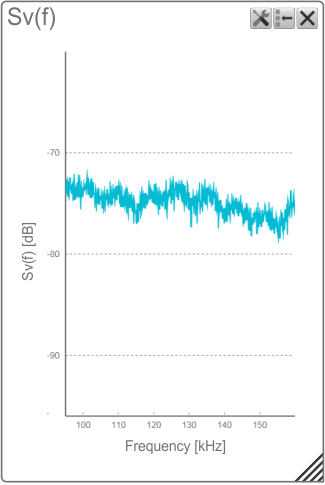Sv(f) information pane description
The Sv(f) information pane shows you the volume backscatter as a function of the frequency. The information is provided as a plot that shows the how the echo strength for a group of targets (for example a school of
fish) change with the operational frequency. This functionality allows you to identify the nature of the schools, and discriminate between them. The Sv(f) information pane can only be used when Pulse Type is set to FM in the Normal Operation dialog box.
Prerequisites
The Sv(f) information pane can only be used when Pulse Type is set to FM in the Normal Operation dialog box.
How to open

To open the Sv(f) information pane, click in the chosen view to activate it, then select the Sv(f) button on the top bar. To close the information pane, select it one more time on the top bar. You can also select Close in the top right corner of the pane.

Description
The Sv(f) information pane is a plot. It shows the how echo strength for a group of targets (for example a school of fish) changes with the operational frequency. The pane allows you to identify the nature of the schools, and discriminate between them.
Tip
In order to study the targets in a volume of water, we recommend that you confine the targets to a dedicated depth layer to
isolate the interesting echoes. The layer would then for example "highlight" a school of fish. Without this layer the default
background layer will be used, but it may often offer too much data from other echoes.
In order to collect information from more than one channel in the Sv(f) information pane, you can use the Combined View Settings functionality to "combine" echo data from several channels. The Combined View Settings dialog box lists all your current channels. On the left side of the dialog box, select which channels to be included in the combined Sv(f) information pane. On the right side, select which channel to be included in the dedicated channel view.
Before you open an information pane, you must first click in an echogram view to make it "active". By doing this you select the channel. In most cases, the data in the information pane is only valid for the selected channel. In this context, the term channel is used as a common term to identify the combination of transceiver, transducer and operating frequency.
You can easily change the physical size and shape of each information pane. Click in its lower right corner, and drag to a new size. To reset the information pane to its default size, select the Reset size button in its top right corner.
The Transparency function allows you to adjust how much you are able to see "through" the information panes you have opened. You can adjust the setting from 0% (no transparency) to 90% (almost full transparency) in steps of 10%.

Details
Close
Select this button to close the information pane. The pane closes immediately. If you wish to reopen it, simply click the button on the top bar one more time.
Reset Size
You may have manually changed the physical size of the information pane. To reset the information pane to its default size, select the Reset size button in its top right corner.
Setup
Select Setup to open the Information Pane Options dialog box. This dialog box allows you to change the presentation parameters related to the information pane.